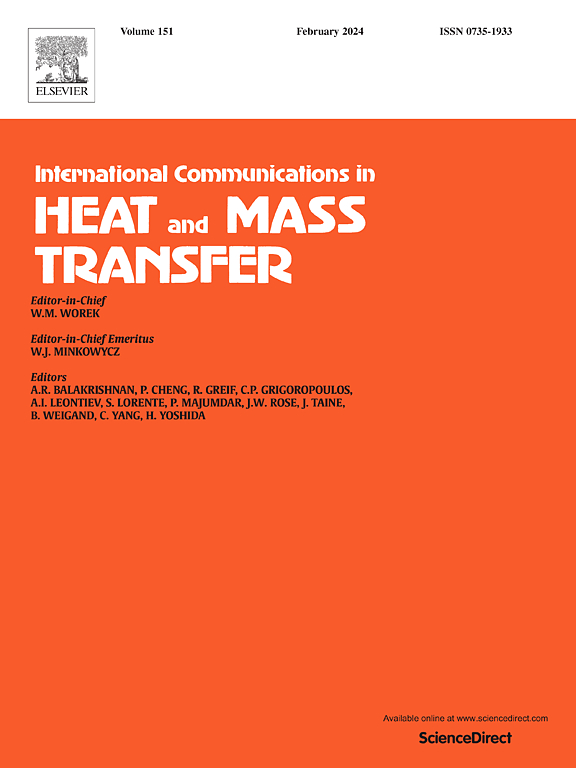Coupled heat and mass transfer analysis inside peak regulation LNG vaporizer with porous flow guiding device
IF 6.4
2区 工程技术
Q1 MECHANICS
International Communications in Heat and Mass Transfer
Pub Date : 2025-07-17
DOI:10.1016/j.icheatmasstransfer.2025.109336
引用次数: 0
Abstract
In the application of natural gas industry, the flexible adjustment of load needs the support of peak regulation vaporization equipment. The vaporizer presented in this paper can be widely used in areas not yet connected to the natural gas pipeline network, and can undertake emergency gas supply tasks for different demand levels. Since this vaporizer uses natural gas combustion as a heat source, there is an urgent need to improve the efficiency of heat utilization. Machining some holes in the flow guiding device is an effective way to increase the efficiency of heat utilization. Therefore, in this study, the heat and mass transfer model of gas-liquid jet entrainment droplet is established and the coupled thermal flow field with different opening rate (0 %, 20 %, 25 %, 30 %) porous flow guiding device is analyzed. Unlike the previous studies that only considered convective heat transfer, the radiative heat transfer factor is also considered in this study. Numerical results show that the proportion of radiative heat transfer can reach 16.9 % under the non-opening condition, indicating that the radiation effect is essential. The proportion of total heat transfer and radiant heat transfer can be increased by using the porous flow guiding device. Compared with non-opening condition, the total heat transfer increases by 19.03 % in the case of 25 % opening rate, and the proportion of radiation heat transfer increases by 14.72 %.

多孔导流装置调峰液化天然气汽化器内部传热传质耦合分析
在天然气工业应用中,负荷的灵活调节需要调峰汽化设备的支持。本文提出的汽化器可广泛应用于尚未接入天然气管网的地区,可承担不同需求水平的应急供气任务。由于该汽化器采用天然气燃烧作为热源,因此迫切需要提高热利用效率。在导流装置上加工一些孔是提高导流装置热利用效率的有效途径。因此,本研究建立了气液射流夹带液滴的传热传质模型,并对不同开度(0%、20%、25%、30%)多孔导流装置的耦合热流场进行了分析。与以往的研究只考虑对流换热不同,本研究还考虑了辐射换热因素。数值计算结果表明,在非开启条件下,辐射换热比例可达16.9%,表明辐射效应是必不可少的。采用多孔导流装置可以提高总传热和辐射传热的比例。与非开启工况相比,开启率为25%时总换热增加19.03%,辐射换热占比增加14.72%。
本文章由计算机程序翻译,如有差异,请以英文原文为准。
求助全文
约1分钟内获得全文
求助全文
来源期刊
CiteScore
11.00
自引率
10.00%
发文量
648
审稿时长
32 days
期刊介绍:
International Communications in Heat and Mass Transfer serves as a world forum for the rapid dissemination of new ideas, new measurement techniques, preliminary findings of ongoing investigations, discussions, and criticisms in the field of heat and mass transfer. Two types of manuscript will be considered for publication: communications (short reports of new work or discussions of work which has already been published) and summaries (abstracts of reports, theses or manuscripts which are too long for publication in full). Together with its companion publication, International Journal of Heat and Mass Transfer, with which it shares the same Board of Editors, this journal is read by research workers and engineers throughout the world.

 求助内容:
求助内容: 应助结果提醒方式:
应助结果提醒方式:


